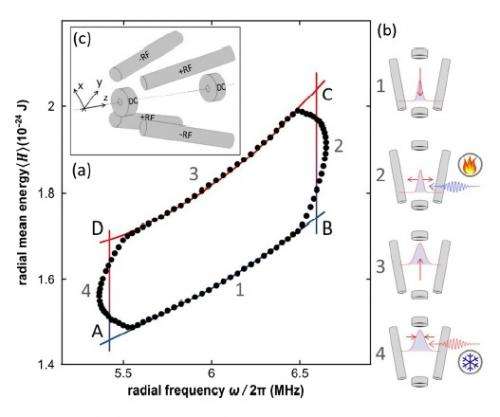November 30, 2012 feature
Can a car engine be built out of a single particle?

(Phys.org)—As physicists work on miniaturizing devices, they will eventually run into the ultimate limit: the atom. A fundamental question in this area is whether it's even possible to scale down a macroscale engine such as a car engine to the single-particle level, while retaining the same working principles. In a new study, a team of physicists has proposed a scheme to build a heat engine that consists of a single trapped ion that can perform a quantum version of the Otto cycle, the basis of the common four-stroke car engine. If realized, the single-ion engine has the potential to enter the quantum regime and become a tool to investigate how quantum effects alter a nanoengine's efficiency.
A group of scientists from the Universities of Augsburg, Berlin, and Mainz in Germany, and of Maryland in the US, has published their proposal for a single-ion heat engine in a recent issue of Physical Review Letters. Previously, researchers have fabricated micro heat engines, but a quantum heat engine that is subject to quantum effects has not yet been realized.
"Our numerical simulations, done with realistic parameters, show that the implementation of a quantum single-ion heat engine is feasible with currently available technology," coauthor Eric Lutz of the Universities of Augsburg and Berlin told Phys.org. "Once built, this would be the smallest and the first quantum heat engine ever fabricated."
The proposed engine consists of a single ion trapped in a Paul trap with tapered geometry. The trapped ion is alternatingly coupled to two reservoirs of different temperatures that heat and cool the radial state of the ion. Heating and cooling causes the ion to move coherently inside the trap, generating an Otto cycle in which thermal energy is converted into motion. Ion movement in the axial direction corresponds to the movement of a piston in a classical engine, while ion movement in the radial direction corresponds to the gas in the cylinder.
The scientists explain that the alternative coupling to the two heat reservoirs can either be switched externally or by the motion of the ion itself; in the latter case, after reaching an initial threshold amplitude, the engine would operate autonomously.
Through analytical and numerical analysis, the researchers showed that the single-ion engine is capable of operating at a maximum efficiency of 30% at maximum power under certain conditions. The parameters of the engine can also be widely tuned, allowing the engine to operate at temperatures low enough to enter the quantum regime.
The scientists also proposed a way to store the energy produced by the engine using a mechanism based on the Paul trap's tapered geometry. The tapering allows energy to be stored in the axial mode and then transferred to other oscillator systems, such as separately trapped ions, so that the energy can be extracted and used to perform work.
"We regard the single-ion engine as a prototype for general oscillator engines, based for instance on nanomechanical oscillators," Lutz said. "These have already been used to fabricate microengines. When run as a heat pump, such an engine could offer an alternative method to locally cool a given mode, for instance in an ion chain or in a nanomechanical oscillator."
Since publishing their paper, Lutz and his coauthors have worked further on the design of a trap with a tapered geometry, and they are currently trying to build the single-ion heat engine.
More information: O. Abah, et al. "Single-Ion Heat Engine at Maximum Power." PRL 109, 203006 (2012). DOI: 10.1103/PhysRevLett.109.203006
Journal information: Physical Review Letters
Copyright 2012 Phys.org
All rights reserved. This material may not be published, broadcast, rewritten or redistributed in whole or part without the express written permission of PhysOrg.com.





















